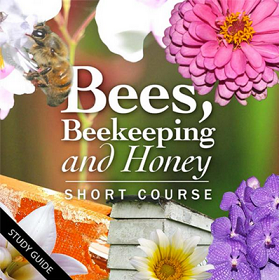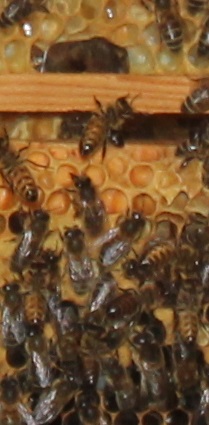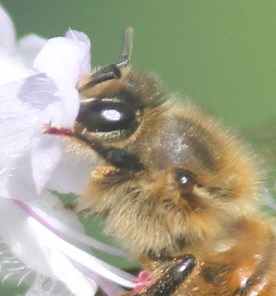
Sneak Peek
Learn all about bees!
Learn to all about bees, from biology and breeds to beekeeping, honey
production, using bee products and managing bees in the landscape. This
course is a great foundation for anyone interested in beekeeping or
simply interested in learning more about bees, honey and other bee
products.
There are 8 lessons as follows; with interactive self assessment
tests to revise what you have learned at the end of each lesson.
COURSE LESSONS
This course covers the following lessons:
Lesson 1- Scope and nature of bees and beekeeping
- Locating a hive
- Types of bees
Lesson 2- Bee biology
- Bee physiology
- Castes and their roles
Lesson 3- Equipment, materials, obtaining bees
- Obtaining bees
- Step by step honey extraction
Lesson 4- The Hive – types, construction, inspection
- The hive
- Choosing the right hive
- Inspecting hives
Lesson 5- Working Bees: seasonal husbandry and harvesting
- Seasonal tasks
- Honey production
- Working with the different bee species
- Review what you have been learning
Lesson 6- Bee Health Management
Lesson 7- Bees in the Landscape
- Attracting bees to your garden
Lesson 8- Using Honey and Bee Products
Final Assessment
Learn About Different Types of Bees
 There are actually thousands of different bee species, and different types of bees within even a species. Most of our commercial honey comes from the Honey Bee which is one, widely distributed species. There are other species though that are also kept for honey production.
There are actually thousands of different bee species, and different types of bees within even a species. Most of our commercial honey comes from the Honey Bee which is one, widely distributed species. There are other species though that are also kept for honey production.
Within the honey bee species there are many different varieties, some occurring naturally, and others have been developed over many centuries by beekeepers. There are also different types of bees, each with specialised functions, within a species (eg. drones, workers, the queen)
What Do Worker Bees Do?
Workers are well named. Smaller than the queen or drones, the worker bees are female and perform all the hard work of supporting and maintaining the hive and make up most of the population within a hive. They collect nectar and pollen; carry a sting (unlike drones), and have a wax gland (to make bees’ wax). On their hind legs, they have specialized spines for carrying propilis (see later). The worker bee also has a crop (or stomach) separate from the nectar crop, for the purpose of water collection.
The life of a worker bee is divided into two distinct stages. The first few weeks are spent as ‘house’ bees, performing tasks within the hive which change as the worker bee ages. After this, the worker begins a period of service as a field bee, foraging for nectar, pollen, propolis and water.
House Bees
In the first 10 to 12 days of life, newly emerged worker bees progress from cleaning cells, to removing the carcases of dead bees to prevent disease in the hive, then to feeding honey and pollen to older larvae, and lastly to feeding royal jelly to selected young larvae. During these last two stages, the workers are considered ‘nurse’ bees since they feed and care for the young and also to tending the queen.
Nurse bee physiology changes as the bee ages, to produce a range of secretions to meet the needs of the hive. ‘Worker jelly’ is produced to feed larvae from 1 to 2 days old, and ‘bee milk’ is made for worker larvae greater than two days old. Worker Jelly consists of a mixture of a white, fat-rich secretion from the nurse bee’s mandibular glands and a clear, protein-rich secretion from the hypo-mandibular glands. Bee milk, in contrast, combines a ‘jelly’ from the hypo-mandibular glands with a nectar-rich fluid from the nurse bee’s honey sack. This change from worker jelly to bee milk also provides the growing larvae with higher sugar levels and a change in sugar type, from largely glucose to largely fructose sugars.
Practical Tip:
Well-fed nurse bees will keep the young larvae ‘swimming’ in jelly. Lack of ‘wet’ brood is a sign that the colony is short on protein, and might benefit from being given a pollen supplement.
After service as a nurse bee, a worker bee’s role shifts to hive management. Over the next 10 days or so, the worker bee will produce wax for hive cell building and repair, store and ripen honey, take on temperature-control duties and guard the hive. Each of these roles corresponds to changes in the bee’s physiology as it matures, so it is ready and able to fulfil the duties at each stage.
At around 12 days old, the worker bee’s wax glands become active. There are four sets of these glands located within the last four segments of the bee’s abdomen, and the wax is exuded from between segments of the abdomen as flaky deposits. The wax itself is produced from the honey consumed by the bees – it’s estimated that it takes up to 3kg of honey to produce 0.5kg of beeswax.
The wax flaxes deposited by the bees are collected, chewed and deposited by other bees to build and repair the comb and store honey and pollen. In a managed hive, the bees build on top of wax a foundation provided by the beekeeper.
The hive must be kept at a steady temperature to ensure the wax stays malleable and at the correct building consistency. Temperature control is also essential for the survival of larvae and young bees; encased within their wax cells, bee larvae require a consistent temperature between 32° C and 35° C for survival. This is another job for the worker bee. From around 18 days of age, these bees begin the task of wing fanning to manage and direct air flow within the hive. They also collect water from sources close to the hive (carrying it in a water ‘crop’ within their body), and are believed to spread it over other workers and the hive to help with evaporative cooling. Worker bees also provide ‘heat shielding’. When high temperatures are localised, they press their bodies against the wall of the brood nest to physically extract the heat, transferring it inside their bodies and carrying it to other parts of the hive. Lastly, when temperatures drop, worker bees have been found to contract and relax the muscles in their thorax, in a ‘shivering’ type motion, to generate heat.
At around 21 days of age, worker bees take on guard duties for a number of days, since this is the time of life at which their stinger venom is most potent. The number of guard bees within a colony varies with bee species, from around 2000 in hives where European bee genes are present to up to 5 times this amount in high in African bee genetics. Guard bees that are ‘killed in the line of duty’ will be rapidly replaced by other worker bees.
Guarding is a specific duty, requiring the bees to stand at the entrance of the hive and check and challenge every returning worker. Guards stand ‘on duty’ on their back legs with front legs and antennae raised, and use pheromones and ‘smell’ to distinguish hive members from foreign bees and other intruder insects. Some none-hive bees are allowed to pass, including most foreign drones. They will also leave the hive for short distance to fend of larger intruders such as beekeepers!

Field Bees
From around 21 days of age, the worker bee begins its role as a forager for nectar, pollen, propolis and water. This is an intense process, and in high season a worker bee will die after only 5 to 6 weeks from pure exhaustion. During the winter season a worker bee may live from 4 to eight months.
The bee collects nectar from flowers using its long tongue (glossa). This sugary mixture, consisting of around 80% water and 20% sugars, is repeatedly ‘swallowed’ and regurgitated from the worker bee’s nectar (or ‘honey’) stomach. During this process, it mixes with enzymes from the hypopharyngeal gland and stomach acids and is partly digested. This allows the sucrose in nectar to be broken down to the simpler sugars fructose and glucose. The digestion enzymes also convert some of the glucose to gluconic acid, reducing the pH (acidity) of honey to between 3 and 4.5 The low water level and high acidity of honey help to explain its bacteriostatic properties (i.e. the low growth of moulds and bacteria).
When the bee returns to the hive, the contents of the honey stomach is transferred by mouth to worker bees within the hive which transfer it for storage to wax cells within the comb. Some of the processed nectar (honey) is also stored in rings of cells around the brood nest, as food for the nurse bees and a first meal for newly emerged workers. The transfer and storage process, along with the internal temperature and airflow in the hive, act to maximise evaporation of water from the honey. Once the workers are happy with the amount of evaporation, they seal the cell with a wax cap. This is usually when the modified nectar (honey) is about 17% to 18% water.
Unlike their nectar-hunting sisters, pollen-foraging bees carry their pollen directly to the comb. The pollen collects on ‘hairs’, sometimes known as ‘pollen baskets’ on the bee’s legs as they travel from flower to flower. On their return to the hive, the bees use their heads to pack the pollen into cells alongside the brood nest, in some cases sealing it with honey for use next season.
The pollen and honey that are stored are intended as food for the hive, designed to feed the bees through winter and periods of low nectar availability, such as bad weather. Newly emerged workers feast on first honey then pollen, stored next to the brood cells for that purpose. Honey is essentially energy in the form of simple sugars. The pollen is necessary for building protein levels within the workers, and forager bees can collect up to 40kg of pollen each year. Pollen also provides lipids (fats), vitamins and minerals and micronutrients for bee health and development. Once the workers become foragers, they rely on protein-rich jelly from young nurse bees to provide them with essential protein.
The third main target of foraging bees is propolis. Propolis is a red or brown resin-like substance made from tree saps, tree buds or similar. When seasonally available, a foraging worker bee collects the sap or similar plant products, mixes it with wax and stores it in its collection ‘baskets’ on its legs. Once returned to the hive, the propolis is used as bee ‘cement’ for building and repair, sealing cavities, and as part of ventilation structures.
Course Features:
- Enrol any time.
- Start studying immediately or later (as you wish).
- Configure your study sessions at any length and frequency you wish.
- Work through at your own pace.
- Help desk - contact via email any time
- Automated
self assessment tests pop up at the end of each lesson. You can attempt
these as many times as you wish; and each time, upon completion, you
can see your results. You will need internet access to complete the self assessment tests.
- At the end of the whole course, you
are presented with a major automated examination which can be attempted
online, anywhere, any time.
- If you achieve a 60% pass in the exam; you immediately receive a downloadable certificate of completion with your name on it.
WHAT WILL YOU GET FROM THIS COURSE?
At the end of this course you will learn how to select bees, different types of bees, build and inspect hives; you will learn how the production of honey can be improved, how to avoid pests and more.